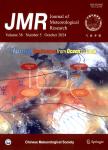Long-Term Trend in Potential Vorticity Intrusion Events over the Pacific Ocean: Role of Global Mean Temperature Rise
Long-Term Trend in Potential Vorticity Intrusion Events over the Pacific Ocean: Role of Global Mean Temperature Rise作者机构:Center for Monsoon System Research Institute of Atmospheric Physics Chinese Academy of Sciences
出 版 物:《Journal of Meteorological Research》 (气象学报(英文版))
年 卷 期:2017年第31卷第5期
页 面:906-915页
核心收录:
学科分类:07[理学] 070601[理学-气象学] 0706[理学-大气科学]
基 金:Supported by the National Natural Science Foundation of China(41675061 4167050403 41550110500 and 41750110484)
主 题:potential vorticity (PV) intrusion Pacific Ocean westerly duct subtropical jet Walker circulation glob-al warming
摘 要:In this study, we examine a long-term increasing trend in subtropical potential vorticity (PV) intrusion events over the Pacific Ocean in relation to the global mean temperature rise, based on multiple reaualysis datasets. The fre- quency of the PV intrusions is closely related to the upper-tropospheric equatorial westerly duct and the subtropical jet (STJ). An overall strengthening of the westerly duct and weakening of the STJ are found to be driven by the warming-induced strengthening of Walker circulation and regional changes in Hadley circulation on multi-dccadal timescalc, leading to an increase in the PV intrusion frequency over the tropics. The results are robust in all datasets. The multi-decadal strengthening in the Pacific Walker circulation is consistent with the global mean temperature rise. In this way, the PV intrusions are correlated with the wanning related global mean temperuate rise. When the interan- nual variability of ENSO is removed from the intrusion time series, the long-term trend in PV intrusions due to ex- ternal forcing associated with anthropogenic warming (global mean temperature rise) becomes clearer. The link between the global mean temperature rise and intrusion frequency is further verified by performing a correlation ana- lysis between the two. The significant (〉 95%) correlation coefficient is 0.85, 0.94, 0.84, 0.83, and 0.84 for ERA-40, ERA-Interim, NCEP-NCAR, JRA-55, and JRA-25, respectively. This unequivocally indicates that the global mean temperature rise can explain around 69%--88% of the variance related to the lung-term increase in PV intrusion fre- quency over the Pacific Ocean.



